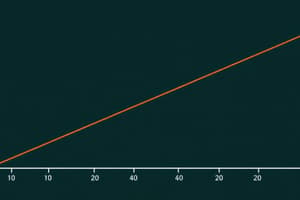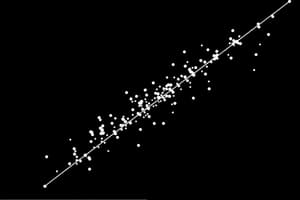Podcast
Questions and Answers
What does correlation analysis describe?
What does correlation analysis describe?
- Categorical variables
- Non-linear relationships between variables
- The presence of outliers in a dataset
- The strength and direction of the linear relationship between two variables (correct)
Why is understanding correlation important in various fields?
Why is understanding correlation important in various fields?
- To measure the quantity of data
- To provide valuable insights into how different factors interact (correct)
- To establish causal relationships
- To identify categorical data
How is correlation analysis utilized in finance and economy?
How is correlation analysis utilized in finance and economy?
- To predict future stock prices accurately
- To evaluate the risk associated with investment portfolios (correct)
- To identify outliers in financial datasets
- To perform sentiment analysis on social media data
What can investors achieve by using the correlation coefficient?
What can investors achieve by using the correlation coefficient?
Why do financial analysts analyze stock prices using correlation analysis?
Why do financial analysts analyze stock prices using correlation analysis?
What role does correlation analysis play in making predictions based on collected data?
What role does correlation analysis play in making predictions based on collected data?
What is the purpose of correlation analysis in social sciences?
What is the purpose of correlation analysis in social sciences?
How do engineers and technology experts utilize correlation analysis?
How do engineers and technology experts utilize correlation analysis?
In healthcare, what is the importance of correlation analysis?
In healthcare, what is the importance of correlation analysis?
How do marketers and advertisers benefit from correlation analysis?
How do marketers and advertisers benefit from correlation analysis?
What does correlation analysis help climatologists achieve in climate studies?
What does correlation analysis help climatologists achieve in climate studies?
Why is understanding the relationship between variables important in various real-world applications?
Why is understanding the relationship between variables important in various real-world applications?
How does exposure to artificial physical elements in urban settings impact mental health?
How does exposure to artificial physical elements in urban settings impact mental health?
What is a significant difference in rates of psychiatric disorders between urban and rural areas?
What is a significant difference in rates of psychiatric disorders between urban and rural areas?
What factor contributes to the increased risk of psychiatric disorders in urban environments?
What factor contributes to the increased risk of psychiatric disorders in urban environments?
How do alterations in neural function potentially contribute to mental disorders in urban settings?
How do alterations in neural function potentially contribute to mental disorders in urban settings?
Why are biomarkers of mental illnesses increased in urban settings compared to rural areas?
Why are biomarkers of mental illnesses increased in urban settings compared to rural areas?
How can extended exposure to artificial light impact individuals?
How can extended exposure to artificial light impact individuals?
What can heightened exposure to threatening stimuli in urban areas, combined with genetic predispositions, potentially lead to?
What can heightened exposure to threatening stimuli in urban areas, combined with genetic predispositions, potentially lead to?
How does urban living affect brain connectivity and function?
How does urban living affect brain connectivity and function?
What impact can exposure to novel stimuli in urban environments have on neurons?
What impact can exposure to novel stimuli in urban environments have on neurons?
What neurological outcome can modifications in gene expression patterns and neural plasticity potentially contribute to?
What neurological outcome can modifications in gene expression patterns and neural plasticity potentially contribute to?
Which of the following is a potential cognitive impairment resulting from prolonged urban stressors and reduced access to natural environments?
Which of the following is a potential cognitive impairment resulting from prolonged urban stressors and reduced access to natural environments?
Flashcards are hidden until you start studying
Study Notes
Introduction
Relationships between variables can provide valuable insights into how different factors interact with each other. One of the most common ways to measure this relationship is through correlation, which describes the strength and direction of the linear relationship between two variables. Understanding the concept of correlation is essential in various fields such as finance, economics, social sciences, engineering, biology, and many more. In this article, we will discuss the importance of finding relationships in real-world applications using correlation analysis, its significance, and some real-world examples of its application.
Correlation in Real-World Applications
Correlation analysis has been widely used across several industries to understand relationships and make predictions based on the data collected. Some of the notable areas where correlation analysis plays a significant role include:
Finance & Economy
In finance and economy, correlation analysis is often used to evaluate the risk associated with investment portfolios. For example, investors can use the correlation coefficient to identify diversified investments that have low correlations among them, thereby reducing the overall risk of their portfolio. Similarly, financial analysts analyze stock prices to determine if they are highly correlated or if there are changes occurring independently, potentially indicating new business trends or market conditions.
Social Sciences
In the field of social sciences, correlation analysis helps researchers draw conclusions about causality by examining relationships between variables like crime rates, population growth, education levels, and economic development. By comparing the correlation coefficients from different studies, researchers can infer whether certain phenomena are related or not.
Engineering & Technology
Engineers and technology experts utilize correlation analysis to study the reliability of industrial systems and equipment. By calculating the correlation between time-to-failure and environmental factors such as temperature, humidity, or usage levels, engineers can predict when components may fail and plan maintenance schedules accordingly.
Healthcare
In healthcare, correlation analysis is crucial in understanding the association between health outcomes and individual factors such as age, sex, race, lifestyle choices, or genetic backgrounds. This knowledge can help healthcare providers tailor treatment plans and improve patient care, especially in chronic diseases like diabetes or heart disease.
Marketing & Advertising
Marketers and advertisers use correlation analysis to gauge consumer behavior, preferences, and responses to marketing campaigns. They can track correlations between customer demographics, purchasing patterns, and brand loyalty to optimize advertising strategies and increase revenue.
Climate Studies
Climatologists employ correlation analysis to assess the impact of climate change on the environment. By analyzing the correlation between environmental variables like temperature and precipitation over extended periods, scientists can anticipate future weather patterns and adjust agricultural practices accordingly.
Conclusion
Understanding the relationship between variables is vital in various real-world applications, and correlation analysis provides a statistical tool to assess these relationships. It enables stakeholders from diverse sectors to make informed decisions, establish cause-and-effect relationships, and develop targeted interventions. As the world becomes increasingly data-driven, the ability to analyze correlation effectively can lead to better performance, improved decision-making, and more precise forecasting.
Studying That Suits You
Use AI to generate personalized quizzes and flashcards to suit your learning preferences.




